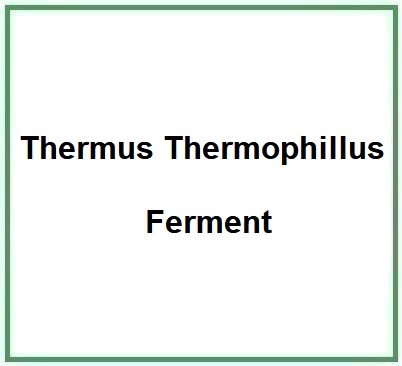Thermus Thermophillus Ferment is a compound of natural origin obtained from one of the most widespread kinds of thermophilic bacteria.
The name describes the structure of the molecule
- "Thermus Thermophillus" refers to the specific type of thermophilic bacterium that thrives in high temperature environments between 45 μs and 85 μs with pH 6.5 and 9.0 (1).
- "Ferment" indicates that the product is derived from a fermentation process using the bacterium Thermus Thermophillus.
Description of raw materials used in production
- Thermus Thermophillus
- Growth Medium - Typically a nutritious liquid suitable for bacterial growth.
Step-by-step summary of industrial chemical synthesis process
- Cultivation - The Thermus Thermophillus bacterium is cultivated in an appropriate growth medium.
- Fermentation - The bacterium grows and multiplies, producing metabolites and other compounds during the process.
- Harvesting - Once the bacterium has fermented the growth medium for an optimum period, the culture is harvested.
- Lysis - The bacterial cells are lysed, or broken down, to release beneficial compounds inside.
- Separation and Filtration - The lysed mixture is then separated and filtered to remove cellular debris and solid particles.
- Purification - The filtrate is further purified, if necessary, to isolate the ferment of interest.
- Quality Control - A quality check is done on the ferment to ensure it meets the desired specifications.
What it is for and where
Cosmetics
Skin conditioning agent. It is the mainstay of topical skin treatment as it has the function of restoring, increasing or improving skin tolerance to external factors, including melanocyte tolerance. The most important function of the conditioning agent is to prevent skin dehydration, but the subject is rather complex and involves emollients and humectants that can be added in the formulation.
Commercial applications
Applicazioni biotecnologiche. Thermus Thermophillus is used as a thermostable mutant selector from mesophilic proteins by direct evolution (2).
Cosmetics. Used for its antioxidant and protective properties to combat oxidative stress and shield the skin from environmental damage.
Anti-aging Products. Incorporated into formulations to counteract signs of aging and enhance skin luminosity and texture.
Sensitive Skin Care. Valued for its soothing properties, it's often found in products intended for sensitive or irritated skin.
Sunscreen Products. Employed in sunscreen formulations to enhance skin protection from UV rays and heat (3).
Moisturizing Creams. Included in creams and lotions to provide deep hydration and fortify the skin barrier.
References_____________________________________________________________________
(1) Oshima, T., & Imahori, K. (1974). Description of Thermus thermophilus (Yoshida and Oshima) comb. nov., a nonsporulating thermophilic bacterium from a Japanese thermal spa. International Journal of Systematic and Evolutionary Microbiology, 24(1), 102-112.
Abstract. The properties of an extremely thermophilic bacterium isolated from water at a Japanese hot spring and previously named Flavobacterium thermophilum are described. The cells are gram-negative, nonsporulating, aerobic rods containing yellow pigment. The optimum temperature for growth is between 65 and 72 C, the maximum being 85 C and the minimum being 47 C. The guanine plus cytosine content of the deoxyribonucleic acid of the thermophile is 69 mol %. This microorganism is sensitive to various antibiotics including those which are known to be rather ineffective against gram-negative bacteria. Spheroplast-like bodies are formed upon treating intact cells with egg-white lysozyme at 60 C. The spheres are osmotically more stable than mesophile protoplasts, and their rupture under hypotonic conditions is not complete unless 0.5% Brij 58 is added to the suspension. Bulk protein extracted from this thermophile is much more stable to heat than mesophile proteins, and only about 10% of the total protein is denatured by heating at 110 C for 5 min. Nevertheless, the amino acid composition of the bulk protein is similar to that of mesophile proteins. As the properties of this organism are similar to those of Thermus aquaticus (Brock and Freeze) and inasmuch as Flavobacterium is a poorly defined genus, this thermophilic microorganism is transferred to the genus Thermus as T. thermophilus (Yoshida and Oshima) comb. nov. The type strain is HB8 (=ATCC 27634).
(2) Cava F, Hidalgo A, Berenguer J. Thermus thermophilus as biological model. Extremophiles. 2009 Mar;13(2):213-31. doi: 10.1007/s00792-009-0226-6.
Abstract. Thermus spp is one of the most wide spread genuses of thermophilic bacteria, with isolates found in natural as well as in man-made thermal environments. The high growth rates, cell yields of the cultures, and the constitutive expression of an impressively efficient natural competence apparatus, amongst other properties, make some strains of the genus excellent laboratory models to study the molecular basis of thermophilia. These properties, together with the fact that enzymes and protein complexes from extremophiles are easier to crystallize have led to the development of an ongoing structural biology program dedicated to T. thermophilus HB8, making this organism probably the best so far known from a protein structure point view. Furthermore, the availability of plasmids and up to four thermostable antibiotic selection markers allows its use in physiological studies as a model for ancient bacteria. Regarding biotechnological applications this genus continues to be a source of thermophilic enzymes of great biotechnological interest and, more recently, a tool for the over-expression of thermophilic enzymes or for the selection of thermostable mutants from mesophilic proteins by directed evolution. In this article, we review the properties of this organism as biological model and its biotechnological applications.
(3) Starch, M., Van Reeth, I., & Ramos, M. C. T. (2007). Expanding Silicone Technologies for Sun Care: Performance Complements Aesthetics. CHEMICAL WEEKLY-BOMBAY-, 53(14), 179.
![]() Thermus Thermophillus Ferment
Thermus Thermophillus Ferment 
